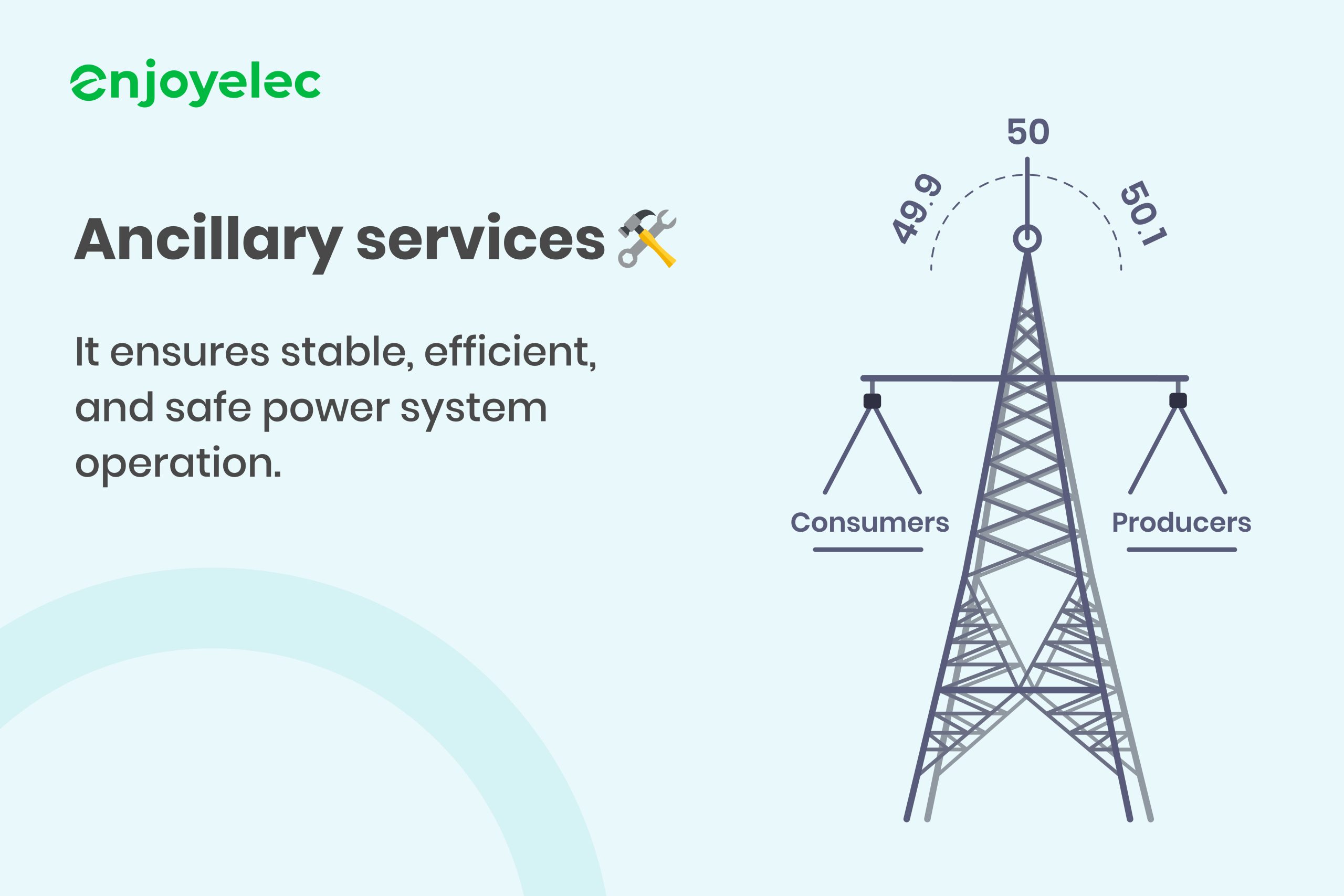Grid Stability: Ancillary Services Explained
August 23, 2024
What are Ancillary Services?
Ancillary services play a crucial role in maintaining the stability and reliability of the power grid. Transmission and distribution grid operators oversee these services, which are essential for keeping frequency, voltage, and power load within safe limits. Unlike other aspects of grid operation, these parameters require constant adjustment, which is where ancillary services come into play.
Smart grid is an advanced version of the traditional grid. It uses digital technology to monitor and manage the flow of electricity more efficiently and reliably. By seamlessly integrating the advantages of distributed computing and advanced communication technologies, it facilitates the dissemination of real-time data, empowering the grid to swiftly achieve a harmonious equilibrium between energy supply and demand.

Type of Ancillary Services
-
Overview: This service helps keep the voltage levels in the power grid steady by managing the flow of reactive power. Reactive power is like a helper that ensures electricity flows properly and keeps the voltage where it should be.
-
Example: If there’s a drop in voltage in a power line because of high demand or distance from the power source, reactive power devices like capacitor banks boost the voltage back to normal. This prevents issues like dim lights or electrical equipment malfunctioning.
- Overview: These reserves are critical for addressing unexpected failures or outages within the power system. They ensure that backup resources are available to compensate for the loss of major components, maintaining system reliability.
- Example: If a large generator fails unexpectedly, contingency reserves can be called upon to provide replacement power. For example, in the event of a generator failure at a power plant, grid operators might activate standby generators or import power from neighboring grids to prevent blackouts and maintain continuous electricity supply.
3.Black-Start Regulation:
-
Overview: This service is designed for grid recovery after a complete blackout. It provides the necessary power to restart and restore the electrical grid when there is a total loss of power across the entire network.
-
Example: After a major blackout, black-start units, such as small, self-starting generators or hydroelectric plants with black-start capability, are used to power up essential infrastructure. For instance, a hydroelectric plant might be brought online first to provide electricity to restart other power plants and critical grid infrastructure, eventually restoring power to the entire grid.
-
Overview: Frequency regulation ensures that the power system’s frequency remains stable by balancing supply and demand in real time. It helps maintain the frequency within a narrow range to prevent disruptions to electrical equipment and grid operations.
-
Example: If there is a sudden drop in power generation, such as from a wind farm experiencing a lull, frequency regulation services respond by either increasing generation from other sources or reducing demand. For example, grid operators might call on battery storage systems to discharge energy into the grid or adjust the output of natural gas plants to keep the frequency steady at 60 Hz in North America or 50 Hz in Europe and many other parts of the world.
Who manages ancillary services in Europe?
In Europe, ancillary services are primarily managed by Transmission System Operators (TSOs). TSOs are responsible for ensuring the stability, reliability, and efficiency of the electricity grid within their respective regions or countries. They coordinate the provision of ancillary services to maintain the balance between electricity supply and demand, manage grid frequency, and ensure voltage stability.
Some of the prominent TSOs in Europe include:
-
TenneT (Netherlands and parts of Germany)
-
National Grid ESO (United Kingdom)
-
RTE (France)
-
Amprion (Germany)
-
Elia (Belgium)
-
Terna (Italy)
These TSOs work closely with electricity generators, energy storage providers, and other stakeholders to procure and manage the necessary ancillary services. Additionally, in some regions, these services may also be coordinated at a broader level through organizations like ENTSO-E (European Network of Transmission System Operators for Electricity), which facilitates cooperation among TSOs across Europe.
How DERs can be used in Ancillary Services?
Here are some examples of how Distributed Energy Resources (DERs) are actively utilized in providing ancillary services to support and stabilize the power grid:
Plug-in electric vehicles (EVs) are increasingly crucial for providing ancillary services to the electric power grid. They serve as decentralized energy storage units, allowing power to flow back into the grid through unidirectional controlled charging (V1G) or vehicle-to-grid (V2G) technology. This capability offers a unique advantage for our users, who can tap into the electricity market’s ancillary services by utilizing our VPP to sell surplus vehicle power back to the grid and potentially earn profits.
The application of smart charging and discharging strategies adds flexibility on both a system-wide and local scale. On a broader level, these strategies help balance the grid by adjusting EV charging patterns to manage peak demand and fill load gaps, aiding in real-time grid stabilization with V1G. Additionally, V2G technology enables EVs to support Transmission System Operators (TSOs) by feeding electricity back into the grid, creating more profit opportunities for users. Locally, smart charging also assists Distribution System Operators (DSOs) with managing grid congestion and helps end-users optimize their energy usage, highlighting the value of EVs as versatile assets in modern power systems.
Energy storage systems play a vital role in enhancing the efficiency and stability of the electric power grid. Their ability to provide essential ancillary services in real-time, and even operate independently of the grid when necessary, makes them increasingly indispensable.
The key ancillary services offered by energy storage systems include regulation and reserves. Regulation services help balance the supply and demand of electricity on short notice, ensuring the grid remains stable. Reserve services, on the other hand, provide backup power to compensate for unexpected outages or drops in generation capacity. As the costs of energy storage systems have come down, these services have become more accessible and widespread, making energy storage a critical component of modern power systems.
-
Solar Systems
Solar PV systems harness sunlight to generate electricity and can enhance grid stability through the use of smart inverters. These inverters can provide reactive power support to regulate voltage levels on the grid. During times of high solar output, PV systems can also contribute to reducing peak demand by supplying additional power, thus helping to alleviate load stress on the grid.
Challenges to Ancillary Service Adoption
-
Complexity of Market Design: Creating efficient EAS markets is a complex task. Balancing factors like cost, competition, and grid security requires careful planning. Traditional market models might struggle with the immediate response and rapid capacity needs that some ancillary services require.
-
Coordinating Diverse Players: The EAS market includes a wide range of players, such as power generators, grid operators, aggregators, and storage providers. Making sure these different groups work together smoothly is crucial for maintaining service quality and grid stability. Challenges include setting up clear communication methods, agreeing on data formats, and aligning everyone’s goals to ensure all participants do their part effectively.
-
Integration of DERs: With more people using distributed energy resources like solar panels and home batteries, there are both new opportunities and challenges. While DERs can offer valuable ancillary services, fitting them into the existing market setup involves overcoming technical and regulatory issues. It’s important to standardize how these resources connect to the grid and create new ways for them to participate in the market.
-
Cybersecurity Risks: As the grid becomes more reliant on digital technologies and automation, the risk of cyberattacks grows. A successful attack could disrupt ancillary services and even cause large-scale power outages. To prevent this, strong cybersecurity measures are needed across all aspects of the electricity system, including communication networks and control systems, to protect the grid’s reliability and the EAS market’s smooth operation.
Future trends of Ancilllary Service
The future of ancillary services in the power sector is set to evolve significantly, driven by emerging trends and technological advancements. As the adoption of renewable energy sources continues to rise, the demand for ancillary services will grow in parallel, ensuring that electricity supply and demand remain balanced in real time. This balance is crucial for regulating voltage and frequency levels, preventing disruptions, and maintaining the overall stability of the grid.
One of the key trends shaping the future of ancillary services is the ongoing innovation in technology, particularly in energy storage. Cost-effective battery storage solutions are transforming the market by providing fast-acting reserves and supporting frequency regulation. These advancements not only enhance grid flexibility but also introduce new options for ancillary services, making the grid more resilient.
The shift towards decentralized power generation is another major trend influencing the future of ancillary services. The increasing penetration of distributed energy resources (DERs), such as rooftop solar panels and local storage systems, is driving the development of localized solutions. This decentralization opens up opportunities for aggregators to pool DER capacity and participate in the ancillary services market, offering more flexible and geographically distributed grid support.
The regulatory landscape is also evolving to keep pace with these changes. Policymakers are adapting regulations to accommodate the new dynamics of the ancillary services market, focusing on creating mechanisms that encourage participation from a diverse range of players, including DERs and aggregators. Additionally, regulations are being updated to address cybersecurity concerns and ensure fair competition within the market.
Finally, as the demand for ancillary services grows, there is an increasing emphasis on cost optimization. New market designs and trading platforms are being developed to promote efficient price discovery and resource allocation. Technological advancements, particularly in energy storage and automation, are contributing to cost reductions by enabling more efficient service provision and grid management.
Overall, the future of ancillary services will be shaped by these emerging trends, leading to a more resilient, flexible, and cost-effective power grid that can meet the demands of a rapidly changing energy landscape.
Download the HEMS app now and step into the world of smart grid.
📱App Store: https://apps.apple.com/us/app/enjoyelec/id6467418530
📱Google Play:https://play.google.com/store/apps/details?id=com.enjoyelec.hems
Connect with us at http://www.linkedin.com/company/enjoyelec for the latest updates, insights, and news. We look forward to engaging with you and sharing our journey towards a smarter energy future.🎉🎊
Subscribe to our free newsletter



